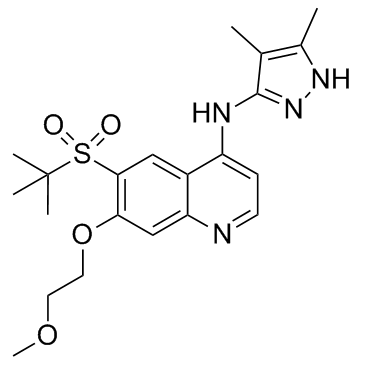
RIPK2-IN-2
CAS No. 1581270-11-2
RIPK2-IN-2( RIPK2-IN-2 | RIPK2 IN 2 | RIPK2IN2 | RIPK2 inhibitor-2 | RIPK2 inhibitor 2 )
Catalog No. M12259 CAS No. 1581270-11-2
A potent, selective receptor interacting protein-2 (RIP2) kinase inhibitor.
Purity : >98% (HPLC)
 COA
COA
 Datasheet
Datasheet
 HNMR
HNMR
 HPLC
HPLC
 MSDS
MSDS
 Handing Instructions
Handing Instructions
| Size | Price / USD | Stock | Quantity |
| 5MG | 312 | Get Quote |


|
| 50MG | 1341 | Get Quote |


|
| 100MG | 1791 | Get Quote |


|
| 200MG | Get Quote | Get Quote |


|
| 500MG | Get Quote | Get Quote |


|
| 1G | Get Quote | Get Quote |


|
Biological Information
-
Product NameRIPK2-IN-2
-
NoteResearch use only, not for human use.
-
Brief DescriptionA potent, selective receptor interacting protein-2 (RIP2) kinase inhibitor.
-
DescriptionA potent, selective receptor interacting protein-2 (RIP2) kinase inhibitor.
-
In VitroRIP2 kinase inhibitor 2 is a novel prodrug of a quinazolyl amine that inhibits RIP2 kinase. Receptor interacting protein-2 (RIP2) kinase is a TKL family serine/threonine protein kinase involved in innate immune signaling. Following activation, RIP2 kinase associates with NODI or NOD2 and appears to function principally as a molecular scaffold to bring together other kinases (TAK1, ΙΚΚα/β/γ) involved in NF-κΒ and mitogen-activated protein kinase activation.
-
In Vivo——
-
SynonymsRIPK2-IN-2 | RIPK2 IN 2 | RIPK2IN2 | RIPK2 inhibitor-2 | RIPK2 inhibitor 2
-
PathwayApoptosis
-
TargetRIP kinase
-
RecptorRIP kinase
-
Research AreaCancer
-
Indication——
Chemical Information
-
CAS Number1581270-11-2
-
Formula Weight432.5364
-
Molecular FormulaC21H28N4O4S
-
Purity>98% (HPLC)
-
Solubility10 mM in DMSO
-
SMILESCOCCOC1=C(S(=O)(C(C)(C)C)=O)C=C2C(NC3=NNC(C)=C3C)=CC=NC2=C1
-
Chemical Name4-Quinolinamine, 6-[(1,1-dimethylethyl)sulfonyl]-N-(4,5-dimethyl-1H-pyrazol-3-yl)-7-(2-methoxyethoxy)-
Shipping & Storage Information
-
Storage(-20℃)
-
ShippingWith Ice Pack
-
Stability≥ 2 years
Reference
1. Linda N. Casillas, et al. Amino-quinolines as kinase inhibitors. PCT Int. Appl. (2014), WO 2014043437 A1 20140320.
molnova catalog



related products
-
Necrostatin 2 racema...
Necrostatin 2 racemate is an potent and specific inhibitor of?RIPK1.
-
RIPK2-IN-5
RIPK2-IN-5 is a receptor-interacting protein kinase 2 (RIPK2) inhibitor with potential anti-inflammatory activity for the study of diseases caused by immune dysfunctions.
-
Oditrasertib
Oditrasertib (DNL-788) is a potent RIPKl inhibitor with an IC50 value of less than 100 nM.



 Cart
Cart
 sales@molnova.com
sales@molnova.com


